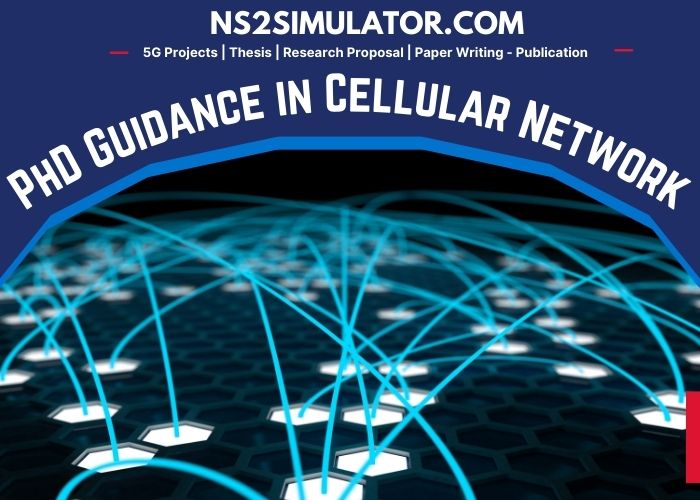Cellular Network is designed by a set of cells where each cell has a certain topographical region with a base station related to 802.11 AP. It helps mobile users to get connected with the network. Also, there is an Access Mode / Air Interface as a communication link of physical and link layer protocol between mobile and base station. For the sake of current PhD scholars, our PhD Guidance in Cellular Network service offers a global research platform that comprises a huge number of unbelievable research topics in cellular technologies.
This page is about the Cellular Network up-to-date research challenges, objectives, and methodologies!!!
Here, all the base stations are linked to Mobile Switching Center which unites cells with a broadband network. And also, it manages call setup for handling mobility in the network. Spreading the coverage areas is difficult to cover by a large cell and increasing the network capacity for those areas that have a higher density of users. Overall, it increases the number of wireless devices and creates communication between them.
Research Challenges in Cellular Networks
- Network Level Challenges
- Need of expanding network coverage
- Requirement of highly scalable networks
- Distributed radio, computing, and caching resources
- Congestion in the core, radio access, and signaling networks
- Device Level Challenges
- Small data packets
- Low battery lifetime
- Ultra-low device complexity
- Diverse QoS requirements
- Dynamic traffic and random access time
Next, our research team shared the research aims of the cellular network that scholars are demanding in a recent study. These are the areas we are currently doing our research to satisfy the scholar’s requests.
Research Objectives in Cellular Network
- Cluster-based Data Aggregation
- Power Allocation and Interference Management
- Mobility Prediction and Traffic Classification
- Resource Discovery, Cell, and Channel Selection
- Dynamic Resource Allocation (Scheduling, Random Access)
Here, our technical professionals have come up with a few vital techniques and procedures that aid in cellular network application development. And, in the case of a challenging solution, we are capable to design our own algorithm or pseudo-code to tackle the research problem.
Research Methods in Cellular Network
- Simulated Annealing
- Multi-Armed Bandit
- K-Means Clustering
- Deep Learning
- Q-Learning
- Deep Neural Network
- Reinforcement Learning
- Bayes Classification
- Fuzzy C-Means Clustering
- Supervised Machine Learning
- Principal Component Analysis (PCA)
What are the applications of the cellular network?
- IoT Sensor Networks – Optimization of pilot overhead
- Multicarrier 5G systems – Design of air interface and waveforms
- IoT Sensor Networks – Coding and Modulation Schemes
- MTC Scenarios – Non-orthogonal Multiple Access
- 5G Cellular Network – Minimization of core network signaling
- Wireless Broadcast Channel – Joint encoding of grouped messages
- Delay-Tolerant IoT/MTC Scenarios – Autonomous Transmission Mode
- 5G Wireless Powered Network – Receiver Algorithms to enhance the reception quality
- Wireless Powered Networks – Energy and information outage performance analysis
- Tactile Internet – Exploitation of frequency diversity to enhance reliability
Next, we can see the performance evaluation of cellular networks through QoS metrics. To provide answers for all research problems, a performance evaluation will perform. However, it focuses on the main issues by providing all the required background information for further analysis and thorough troubleshooting of the major performance-impacting problems in the network.
Major QoS Parameters in Cellular Network
For instance, each cell in a cellular network uses a diverse set of frequencies from nearby cells to avoid intrusion. As well, it aims to provide certain bandwidth within each cell.
- Bandwidth – What amount of data can transfer over some time?
- Range – How next to a base station do you have to be present to acquire a serviceable signal?
- Power – How much power does it carry off to transfer a specific amount of data through the network?
- Latency – How much time it gets held to acquire the transferred data for a receiver. At this time, it calculates the time from when the device executes the command to transfer the data?
In all kinds of networks, cellular network optimization tools are more essential. They enable an improved service quality, a quicker response for performance problems over the network with low operating costs.
What is the best software for cellular network design?
- OMNeT++
- Matlab
- NS3
- GNS3
- Cooja
- CORE
- Opnet Modeller Software
- Vienna System Level Simulator
During our PhD Guidance in Cellular Network, we will help you to know the suitable simulation tool for your hand-picked research topic. Furthermore, our developers have revealed a few Simulation Parameters in Cellular Technologies for your information.
Simulation Parameters in Cellular Network
- Channel bandwidth
- LTE-M – 1.4 MHz
- NB-IoT – 180 KHz
- Transmission mode
- LTE-M – HD-FDD/FDD/TDD
- NB-IoT – HD-FDD
- Peak Data rate
- LTE-M – 375 kbps (HD-FDD), 1 Mbps (TDD)
- NB-IoT – 50 kbps (HD-FDD)
- Latency
- LTE-M – 50-100 ms
- NB-IoT – 1.5-10 seconds
- Noise Figure
- LTE-M – 9 dB (Uplink), 5 dB (Downlink)
- NB-IoT – 5 dB (Uplink), 3 dB (Downlink)
- Maximum Coupling Loss (MCL)
- LTE-M – 155.7 dB
- NB-IoT – 164 dB
- Modes of Operation
- LTE-M – In-band
- NB-IoT – In-band, Guard-band and Standalone
- Power Consumption
- LTE-M – Best at Medium Data Rates
- NB-IoT – Best at Very Low Data Rates
- Mobility Support
- LTE-M – Full Mobility
- NB-IoT – No Connected Mobility
- Voice over LTE Support
- LTE-M – Yes
- NB-IoT – No
In aIn addition, if you want more information about the Cellular Network, then tie up with us. We are ready to give perfect PhD Guidance in Cellular network to reach your goal line.

